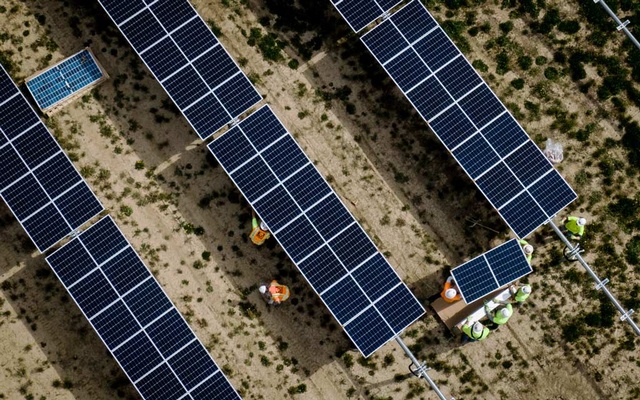
Building solar farms may not build the middle class
NYtimes
Published:18 Jul 2021, 09:11 AM

Building solar farms may not build the middle class
The Green New Deal, first introduced in 2019, sought to “create millions of good, high-wage jobs.” And in March, when President Joe Biden unveiled his $2.3 trillion infrastructure plan, he emphasised the “good-paying” union jobs it would produce while reining in climate change.
“My American Jobs Plan will put hundreds of thousands of people to work,” Biden said, “paying the same exact rate that a union man or woman would get.”
But on its current trajectory, the green economy is shaping up to look less like the industrial workplace that lifted workers into the middle class in the 20th century than something more akin to an Amazon warehouse or a fleet of Uber drivers: gruelling work schedules, few unions, middling wages and limited benefits.
Kellogg Dipzinski has seen this up close, at Assembly Solar, a nearly 2,000-acre solar farm under construction near Flint, Michigan.
“Hey I see your ads for help,” Dipzinski, an organiser with the local electrical workers union, texted the site’s project manager in May. “We have manpower. I’ll be out that way Friday.”
“Hahahahaha …. yes — help needed on unskilled low wage workers,” was the response. “Competing with our federal government for unemployment is tough.”
For workers used to the pay standards of traditional energy industries, such declarations may be jarring. Building an electricity plant powered by fossil fuels usually requires hundreds of electricians, pipe fitters, millwrights and boilermakers who typically earn more than $100,000 a year in wages and benefits when they are unionised.
The Lessons of 2009
Since 2000, the United States has lost about 2 million private-sector union jobs, which pay above-average wages. To help revive such “high-quality middle-class” employment, as Biden refers to it, he has proposed federal subsidies to plug abandoned oil and gas wells, build electric vehicles and charging stations and speed the transition to renewable energy.
Industry studies, including one cited by the White House, suggest that vastly increasing the number of wind and solar farms could produce over half a million jobs a year over the next decade — primarily in construction and manufacturing.
In 2023, a coal- and gas-powered plant called DE Karn, about an hour away from the Assembly Solar site in Michigan, is scheduled to shut down. The plant’s 130 maintenance and operations workers, who are represented by the Utility Workers Union of America and whose wages begin around $40 an hour plus benefits, are guaranteed jobs at the same wage within 60 miles. But the union, which has lost nearly 15% of the 50,000 members nationally that it had five years ago, says many will have to take less appealing jobs. The utility, Consumers Energy, concedes that it doesn’t have nearly enough renewable energy jobs to absorb all the workers.
Union Labour, ‘Where Possible’
In mid-2019, the electrical workers union in Flint elected a trim and tightly coiled man named Greg Remington as its business manager and de facto leader. Around the same time, Remington ran into an official with Ranger Power, the company developing the project for DE Shaw, at a local planning commission meeting.
“He was all smiles — ‘Oh, yeah, we look forward to meeting,’” Remington said of the official. “But he never returned another phone call. I sent emails and he never got back to me.”
Development is the stage of a solar project in which a company buys or leases land, secures permits and negotiates a power purchase agreement with a utility. After that, the developer may cede control of the project to a company that will build, own and operate it.
But the two companies often work in tandem, as in the case of DE Shaw and Ranger Power, which are joint-venture partners “on certain Midwest projects and assets,” according to a Ranger spokeswoman. DE Shaw helps fund Ranger Power’s projects, and its involvement provides the resources and credibility to get projects off the ground.
‘Like a Moving Assembly Line’
On an afternoon in mid-May, several labourers coming off their shift at Assembly Solar said they were grateful for the work, which they said paid $16 an hour and provided health insurance and 401(k) contributions. Two said they had moved to the area from Memphis and two from Mississippi, where they had made $9 to $15 an hour — one as a cook, two in construction and one as a mechanic.
Jeff Ordower, an organiser with the Green Workers Alliance, a group that pushes for better conditions on such projects, said that out-of-state workers often found jobs through recruiters, some of whom make promises about pay that don’t materialise, and that many workers ended up in the red before starting. “You don’t get money till you get there,” Ordower said. “You’re borrowing money from friends and family just to get to the gig.”
The Assembly Solar workers described their jobs installing panels: Two workers “throw glass,” meaning they lift a panel onto the rack, while a third “catches it,” meaning he or she guides the panel into place. Another group of workers passes by afterward and secures the panels to the rack.
To hear Democrats tell it, a green job is supposed to be a good job — and not just good for the planet.